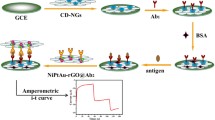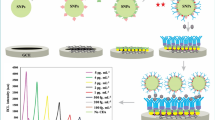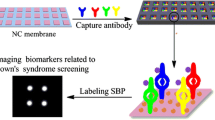Abstract
An ultrasensitive enzyme-linked immunosorbent assay (ELISA) is reported for the determination of carcinoma embryonic antigen (CEA) in human serum. It was realized using a microplate reader using a 384-well plate. Monoclonal antibody (Ab) against CEA (1° Ab) acting as the capture probe was immobilized on zinc oxide nanoparticles (ZnO-NPs) in the form of self-assembled monolayers (SAMs). CEA captured by 1° Ab was quantified using a sandwich ELISA wherein a polyclonal second antibody against CEA (2° Ab) was used for detection and quantified using an HRP-labeled secondary antibody (3° Ab). The ZnO-NPs-CEA capture probe was deposited on the bottom of the wells in order to enhance capture of CEA. A 3-fold enhancement in the chemiluminescence (CL) signal of luminol is found (compared to a conventional ELISA). CEA can be quantified by this method in concentrations as low as 1 pg · mL−1. The upper limit of detection is 20 ng · mL−1. The use of ZnO-NPs also imparts improved thermal stability. When stored at 4 °C in phosphate-buffered saline of pH 7.4, the probe displays stability of up to 30 days.

Schematic of the microplate chemiluminescence sandwich assay for CEA using ZnO-labeled primary antibody and HRP-labeled secondary antibody





Similar content being viewed by others
References
Choi Y-E, Kwak J-W, Park JW (2010) Nanotechnology for early cancer detection. Sensors 10:428–455
Cheow LF, Ko SH, Kim SJ, Kang KH, Han J (2010) Increasing the sensitivity of enzyme-linked immunosorbent assay using multiplexed electrokinetic concentrator. Anal Chem 82:3383–3388
Qu S, Liu J, Luo J, Huang Y, Shi W, Wang B, Cai X (2013) A rapid and highly sensitive portable chemiluminescent immunosensor of carcinoembryonic antigen based on immunomagnetic separation in human serum. Anal Chim Acta 766:94–99
Zhou F, Yuan L, Wang H, Li D, Chen H (2011) Gold nanoparticle layer: a promising platform for ultra-sensitive cancer detection. Langmuir 27:2155–2158
Ambrosi A, Airò F, Merkoçi A (2009) Enhanced gold nanoparticle based ELISA for a breast cancer biomarker. Anal Chem 82:1151–1156
Pei X, Zhang B, Tang J, Liu B, Lai W, Tang D (2013) Sandwich-type immunosensors and immunoassays exploiting nanostructure labels: a review. Anal Chim Acta 758:1–18
Park J-S, Cho MK, Lee EJ, Ahn K-Y, Lee KE, Jung JH, Cho Y, Han S-S, Kim YK, Lee J (2009) A highly sensitive and selective diagnostic assay based on virus nanoparticles. Nat Nanotechnol 4:259–264
Wang G, Huang H, Zhang G, Zhang X, Fang B, Wang L (2011) Dual amplification strategy for the fabrication of highly sensitive Interleukin-6 amperometric immunosensor based on poly-dopamine. Langmuir 27:1224–1231
Cassiday L (2010) Carbon nanotubes stretch the boundaries of biomarker detection. Anal Chem 82:3406
Borras G, Molina R, Xercavins J, Ballesta A, Iglesias J (1995) Tumor antigens CA 19.9, CA 125, and CEA in carcinoma of the uterine cervix. Gynecol Oncol 57:205–211
Grunnet M, Sorensen JB (2012) Carcinoembryonic antigen (CEA) as tumor marker in lung cancer. Lung Cancer 76:138–143
Hammarström S (1999) The carcinoembryonic antigen (CEA) family: structures, suggested functions and expression in normal and malignant tissues. Semin Cancer Biol 9:67–81
Chon H, Lee S, Son SW, Oh CH, Choo J (2009) Highly sensitive immunoassay of lung cancer marker carcinoembryonic antigen using surface-enhanced Raman scattering of hollow gold nanospheres. Anal Chem 81:3029–3034
Kulasingam V, Diamandis EP (2008) Strategies for discovering novel cancer biomarkers through utilization of emerging technologies. Nat Clin Pract Oncol 5:588–599
Pal S, Sharma MK, Danielsson B, Willander M, Chatterjee R, Bhand S (2014) A miniaturized nanobiosensor for choline analysis. Biosens Bioelectron 54:558–564
Solanki PR, Kaushik A, Agrawal VV, Malhotra BD (2011) Nanostructured metal oxide-based biosensors. NPG Asia Mater 3:17–24
Vashist SK, Marion Schneider E, Lam E, Hrapovic S, Luong JHT (2014) One-step antibody immobilization-based rapid and highly-sensitive sandwich ELISA procedure for potential in vitro diagnostics. Sci Rep 4:4407
Willander M, Khun K, Ibupoto Z (2014) Metal oxide nanosensors using polymeric membranes, enzymes and antibody receptors as ion and molecular recognition elements. Sensors 14:8605–8632
Arya SK, Saha S, Ramirez-Vick JE, Gupta V, Bhansali S, Singh SP (2012) Recent advances in ZnO nanostructures and thin films for biosensor applications: Review. Anal Chim Acta 737:1–21
Norouzi P, Gupta VK, Faridbod F, Pirali-Hamedani M, Larijani B, Ganjali MR (2011) Carcinoembryonic antigen admittance biosensor based on Au and ZnO nanoparticles using FFT admittance voltammetry. Anal Chem 83:1564–1570
Casey BJ, Kofinas P (2008) Selective binding of carcinoembryonic antigen using imprinted polymeric hydrogels. J Biomed Mater Res A 87:359–363
Li S-F, Zhang X-M, Du W-X, Ni Y-H, Wei X-W (2008) Chemiluminescence reactions of a luminol system catalyzed by ZnO nanoparticles. J Phys Chem C 113:1046–1051
Arduini F, Amine A, Moscone D, Palleschi G (2009) Reversible enzyme inhibition–based biosensors: Applications and analytical improvement through diagnostic inhibition. Anal Lett 42:1258–1293
Jiang J, Wang Z, Zhang H, Zhang X, Liu X, Wang S (2011) Monoclonal antibody-based ELISA and colloidal gold immunoassay for detecting 19-Nortestosterone residue in animal tissues. J Agric Food Chem 59:9763–9769
Liu N, Feng F, Liu Z, Ma Z (2015) Porous platinum nanoparticles and PdPt nanocages for use in an ultrasensitive immunoelectrode for the simultaneous determination of the tumor markers CEA and AFP. Microchim Acta 182:1143–1151
Wu K, Chu C, Ma C, Yang H, Yan M, Ge S, Yu J, Song X (2015) Immunoassay for carcinoembryonic antigen based on the Zn2+-enhanced fluorescence of magnetic-fluorescent nanocomposites. Sensors Actuators B Chem 206:43–49
Cheng Y, Yuan R, Chai Y, Niu H, Cao Y, Liu H, Bai L, Yuan Y (2012) Highly sensitive luminol electrochemiluminescence immunosensor based on ZnO nanoparticles and glucose oxidase decorated graphene for cancer biomarker detection. Anal Chim Acta 745:137–142
Author information
Authors and Affiliations
Corresponding author
Electronic supplementary material
Below is the link to the electronic supplementary material.
ESM 1
(DOCX 211 kb)
Rights and permissions
About this article
Cite this article
Pal, S., Bhand, S. Zinc oxide nanoparticle-enhanced ultrasensitive chemiluminescence immunoassay for the carcinoma embryonic antigen. Microchim Acta 182, 1643–1651 (2015). https://doi.org/10.1007/s00604-015-1489-5
Received:
Accepted:
Published:
Issue Date:
DOI: https://doi.org/10.1007/s00604-015-1489-5




